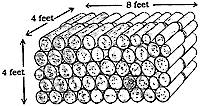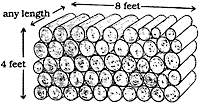Wood Heating
by Michael Kuhns, Extension Forestry Specialist, and Tom Schmidt, Forester*
Introduction
Wood is a source of heat used by many Utahns. More firewood will be burned as the cost of other energy sources like gas and electricity rises. In order to use firewood effectively, an understanding of species characteristics and firewood volumes is needed.
Species Characteristics
Firewood from different species or types of trees varies widely in heat content, burning characteristics, and overall quality. Table 1 presents several important burning characteristics for most species used in Utah.
TABLE 1. Firewood Facts (Sorry for any gaps in the data)
| Species | Weight (lbs./Cord) Green | Weight (lbs./Cord) Dry | Heat per Cord (Million BTUs) | % of Green Ash | Ease of Splitting | Smoke | Sparks | Coals | Fragrance | Overall Quality |
|---|---|---|---|---|---|---|---|---|---|---|
| Alder | 2540 | 17.5 | Easy | Moderate | Good | Slight | ||||
| Apple | 4850 | 3888 | 27.0 | 135 | Medium | Low | Few | Good | Excellent | Excellent |
| Ash, Green | 4184 | 2880 | 20.0 | 100 | Easy | Low | Few | Good | Slight | Excellent |
| Ash, White | 3952 | 3472 | 24.2 | 121 | Medium | Low | Few | Good | Slight | Excellent |
| Aspen, Quaking | 2160 | 18.2 | Easy | Few | Good | Slight | ||||
| Basswood (Linden) | 4404 | 1984 | 13.8 | 69 | Easy | Medium | Few | Poor | Good | Fair |
| Beech | 3760 | 27.5 | Difficult | Few | Excellent | Good | ||||
| Birch | 4312 | 2992 | 20.8 | 104 | Medium | Medium | Few | Good | Slight | Fair |
| Boxelder | 3589 | 2632 | 18.3 | 92 | Difficult | Medium | Few | Poor | Slight | Fair |
| Buckeye, Horsechestnut | 4210 | 1984 | 13.8 | 69 | Medium | Low | Few | Poor | Slight | Fair |
| Catalpa | 4560 | 2360 | 16.4 | 82 | Difficult | Medium | Few | Good | Bad | Fair |
| Cherry | 3696 | 2928 | 20.4 | 102 | Easy | Low | Few | Excellent | Excellent | Good |
| Chestnut | 18.0 | Good | Good | |||||||
| Coffeetree, Kentucky | 3872 | 3112 | 21.6 | 108 | Medium | Low | Few | Good | Good | Good |
| Cottonwood | 4640 | 2272 | 15.8 | 79 | Easy | Medium | Few | Good | Slight | Fair |
| Dogwood | 4230 | High | Difficult | Few | Fair | |||||
| Douglas-fir | 3319 | 2970 | 20.7 | 103 | Easy | High | Few | Fair | Slight | Good |
| Elm, American | 4456 | 2872 | 20.0 | 100 | Difficult | Medium | Few | Excellent | Good | Fair |
| Elm, Siberian | 3800 | 3020 | 20.9 | 105 | Difficult | Medium | Few | Good | Fair | Fair |
| Fir, White | 3585 | 2104 | 14.6 | 73 | Easy | Medium | Few | Poor | Slight | Fair |
| Hackberry | 3984 | 3048 | 21.2 | 106 | Easy | Low | Few | Good | Slight | Good |
| Hemlock | 2700 | 19.3 | Easy | Many | Poor | Good | ||||
| Honeylocust | 4640 | 3832 | 26.7 | 133 | Easy | Low | Few | Excellent | Slight | Excellent |
| Juniper, Rocky Mountain | 3535 | 3150 | 21.8 | 109 | Medium | Medium | Many | Poor | Excellent | Fair |
| Larch (Tamarack) | 3330 | 21.8 | Easy-med | Many | fair | Slight | Fair | |||
| Locust, Black | 4616 | 4016 | 27.9 | 140 | Difficult | Low | Few | Excellent | Slight | Excellent |
| Maple, Other | 4685 | 3680 | 25.5 | 128 | Easy | Low | Few | Excellent | Good | Excellent |
| Maple, Silver | 3904 | 2752 | 19.0 | 95 | Medium | Low | Few | Excellent | Good | Fair |
| Mulberry | 4712 | 3712 | 25.8 | 129 | Easy | Medium | Many | Excellent | Good | Excellent |
| Oak, Bur | 4960 | 3768 | 26.2 | 131 | Easy | Low | Few | Excellent | Good | Excellent |
| Oak, Gambel | 30.7 | |||||||||
| Oak, Red | 4888 | 3528 | 24.6 | 123 | Medium | Low | Few | Excellent | Good | Excellent |
| Oak, White | 5573 | 4200 | 29.1 | 146 | Medium | Low | Few | Excellent | Good | Excellent |
| Osage-orange | 5120 | 4728 | 32.9 | 165 | Easy | Low | Many | Excellent | Excellent | Excellent |
| Pine, Lodgepole | 2610 | 21.1 | Easy | Many | Fair | Good | Fair | |||
| Pine, Ponderosa | 3600 | 2336 | 16.2 | 81 | Easy | Medium | Many | Fair | Good | Fair |
| Pine, White | 2250 | 15.9 | Easy | Moderate | poor | Good | ||||
| Pinyon | 3000 | 27.1 | Easy | Many | ||||||
| Poplar | 2080 | Low | Easy | Many | Fair | Bitter | ||||
| Redcedar, Eastern | 2060 | 13.0 | Easy | Low | Many | Poor | Slight | Fair | ||
| Redcedar, Western | 2950 | 2632 | 18.2 | 91 | Medium | Medium | Many | Poor | Excellent | Fair |
| Spruce | 2800 | 2240 | 15.5 | 78 | Easy | Medium | Many | Poor | Slight | Fair |
| Spruce, Engelmann | 2070 | 15.0 | 78 | Easy | Few | Poor | Slight | |||
| Sycamore | 5096 | 2808 | 19.5 | 98 | Difficult | Medium | Few | Good | Slight | Good |
| Walnut, Black | 4584 | 3192 | 22.2 | 111 | Easy | Low | Few | Good | Good | Excellent |
| Willow | 4320 | 2540 | 17.6 | 88 | Easy | Low | Few | Poor | Slight | Poor |
Green weight is the weight of a cord of freshly cut wood before drying. Dry weight is the weight of a cord after air drying. Green firewood may contain 50% or more water by weight. Green wood produces less heat because heat must be used to boil off water before combustion can occur. Green wood also produces more smoke and creosote (material that deposits on inside walls of chimneys and may cause chimney fires) than dry wood. Firewood should therefore always be purchased dry or allowed to dry before burning. Dry wood may cost more than green wood because it produces more heat and is easier to handle.
A wood's dry weight per volume, or density, is important because denser or heavier wood contains more heat per volume. Osage-orange is a very dense firewood with limited availability in Utah. It's included here to show what a very dense wood is like. It contains almost twice the heat by volume of cottonwood, one of our lightest woods. In general it is best to buy or gather dense woods such as oak, hard maple, or ash. Hardwoods, or woods from broadleaved trees, tend to be denser than softwoods or woods from conifers. Some firewood dealers sell "mixed hardwood" firewood. This may or may not be desirable, depending on the proportion of low- density hardwoods such as cottonwood that are included.
The amount of heat per cord of dry wood is presented in Table 1. Heat content is shown as a percent of dry green ash, a fairly common, dense firewood. Values above 100 signify a higher heat content than green ash and below 100 a lower heat content.
Table 1 also contains information on other characteristics that determine firewood quality. Ease of splitting is important because larger pieces of wood must usually be split for good drying and burning. Fragrance and tendency to smoke and spark are most important when wood is burned in a fireplace. Woods that spark or pop can throw embers out of an open fireplace and cause a fire danger. Conifers tend to do this more because of their high resin content. Woods that form coals are good to use in wood stoves because they allow a fire to be carried overnight effectively.
Firewood Volume
Though firewood dry weight is important for determining heat content, firewood is normally bought and sold by volume. The most common unit of firewood volume is the cord, also known as a standard or full cord. A cord is an evenly-stacked pile containing 128 cubic feet of wood and air space. Though a cord can be piled in any shape, a standard cord is generally thought of as a stack of wood 4 feet tall, 8 feet long, and 4 feet deep (Figure 1). To figure the number of cords in another size or shape pile, determine the pile's cubic foot volume and divide by 128. A randomly-piled stack of wood will generally contain more air and less wood than one neatly piled.
Some dealers sell wood by the face cord or short cord (Figure 2). A face cord is a stack of wood 4 feet high, 8 feet long, and as deep as the pieces are long. Pieces are commonly 12 to 18 inches long, so a face cord may contain 32 to 48 cubic feet of wood and air.
Another common firewood measure is the pickup load (Figure 3). This is a very imprecise but common measure. A full-size pickup with a standard bed can hold about 1/2 of a full cord or 64 cubic feet when loaded even with the top of the bed. Small pickups hold much less. Random loading will decrease this amount further.
A randomly-piled stack or pickup load of wood will contain more air and less wood than one neatly stacked. Crooked, small diameter, and knotty or branchy pieces also reduce the amount of wood in a pile.



Buying Firewood
Species, volume, dryness, and need for splitting should be considered when buying firewood. The information here and in other publications should give you the basic information you will need to be an informed buyer. However, knowing your dealer is the best way to ensure that you are getting what you are paying for.
For More Information
A number of good publications are available to help you learn more about using firewood for heating.
Burning Wood and Coal by Susan Mackay, L. Dale Baker, John W. Bartok, Jr., and James P. Lassoie. 1985. Northeast Regional Agricultural Engineering Service, Riley Robb Hall, Cornell University, Ithaca, NY 14853. (607) 256-7654. 90 pp.
The Wood Burner's Encyclopedia by Jay Shelton and Andrew B. Shapiro. 1976. Vermont Crossroads Press, Box 333, Waitsfield, VT 05673. 155 pp.
Wood Heat Safety by Jay Shelton. 1979. Garden Way Publishing Co., Charlotte, VT 05445. 165 pp.
* Tom Schmidt is a former Forester for the Nebraska Forest Service. This web page is based partly on a University of Nebraska fact sheet titled "Heating With Wood: Species Characteristics and Volumes".

